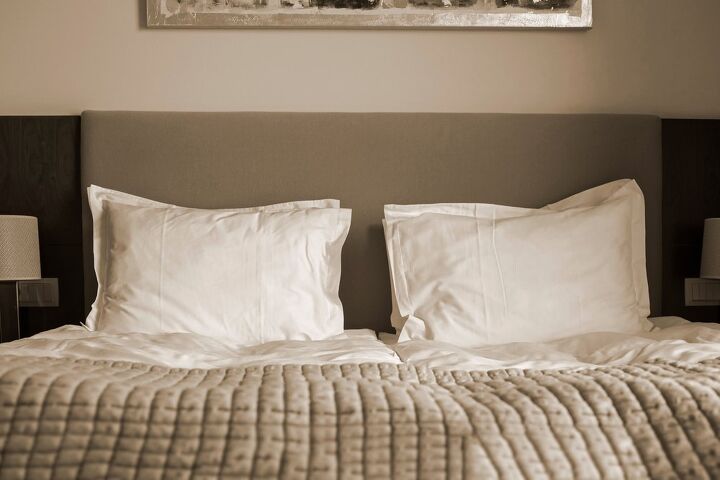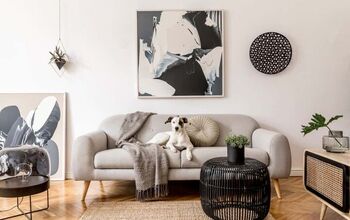14 Bed Alternatives For Small Spaces

Beds are necessary, but they can be a pain when it comes to small spaces. Many homeowners have to choose between comfort and conserving space. With that said, what are best bed alternatives for small spaces that are just as comfortable as they are practical?
Futons, lofts, sofa sleepers, hammocks, recliners, Murphy beds, and bunk beds are the best bed alternatives for small spaces. Air mattresses, storage beds, and trundles are another great option that maximizes space. Bedrolls and cots are the best options if you want an affordable and easy-to-store bed alternative.
14 Bed Alternatives For Small Spaces
Each of these bed alternatives emphasizes maximizing space in your room. Let’s take a deep dive into the best bed alternatives for small spaces.
1. Futon
Futons are a hybrid between a couch and a bed, and that makes them great for small spaces. You can fold your futon up into a couch during the day to quickly maximize your space. This makes futons ideal for small spaces, such as small bedrooms or studio apartments.
The best thing about futons is that they are multi-functional and can be used for years. Futons offer double the value of a traditional bed in that they serve as two pieces of necessary furniture. Not only that, but futons are lightweight and much easier to move than a twin, queen, or king-size bed.
There is no shortage of options for futons from major sellers like Ikea and Nirvana, and they’re readily available. Consider a futon if you have a small space that you want to get the most out of when it comes time to sleep.
Pros- Doesn’t take up much space
- Works as a couch and bed
- Lightweight
- Affordable
- Not as comfortable as a bed
2. Loft
Buy a loft if you want a bed that allows you to store necessary items, such as boxes and wardrobe, underneath it. Lofts are ideal for small rooms because the space beneath the bed allows you to decorate, store clothing, or even put another bed underneath it. Storage is the name of the game with lofts, but it doesn’t hurt that they also look great.
Large lofts even allow you to put a makeshift office space underneath them if that’s what you need. Lofts have a unique look to them that adds character to any room that you decide to put one in. They are just as useful in a child’s room as they are in an adult’s room.
With that said, loft beds are only ideal for one person which can be limited to couples. Luckily, there are enough benefits to lofts that they are a perfect bed alternative for a small space.
Pros- Allows for storage
- Visually appealing
- Safe
- Works for adults and children
- Only one person can sleep on it
3. Bunk Beds
Bunk beds are ideal for small spaces if you have children because of the vertical design. The standard bunk bed dimensions are 75” L x 39” W x 65” H, and that doesn’t take up much space. Use a bunk bed in place of two twin beds side by side to leave more space in the room.
Of course, this option is only ideal for homeowners with children that share a room. Bunk beds are great because they allow you to take advantage of the free space in the room. That means that you won’t have to worry about having a hard time placing dressers, trunks, or other furniture.
As long as you look out for the thickness of your mattresses, you’ll be able to fit most beds in a bunk bed. Consider a bunk bed if you have children that share a room and want to save space.
Pros- Saves space
- Accommodates two people
- Affordable
- People outgrow them quickly
- Can be tricky to assemble
4. Storage Bed
Storage beds are one of the most useful, convenient, and practical bed alternatives for small spaces. You will generally find storage beds with drawers at the bottom for storage. However, some storage beds lift so that you can store items beneath the mattress.
There are storage beds that accommodate every mattress size from twin to king, and they’re easy to find. You still take up the space of a traditional bed, but storage beds allow you to minimize clutter. Storage beds are a great option for homeowners with a small room but plenty of clothing and items that need to be tucked away.
They are similar to loft beds in that they are of normal size, but storage beds give you creative storage options. Go with a storage bed if you want to neatly put away as much as possible without sacrificing bed space.
Pros- Convenient storage
- Variety of options
- Easy to find
- They can be expensive
- Drawers can catch the eye
5. Murphy Bed
You may have seen Murphy beds in many hip studio apartments, but they work just as well in any home. The appeal of Murphy beds is that they don’t take up much space and allow you extra room for storage. You can lift Murphy beds and tuck them neatly up against the wall in the morning like it was never even there.
Murphy beds grant you more space in your room and that is a major help to anyone with a small space. They are expensive, however, and that is due to their popularity, convenience, and installation process. Some Murphy beds even fold up into cabinets on the wall, but this will run you $1,500 or more.
Not all homeowners may want to put down that much money for a bed, but it’s worth it for the use of space. Look into Murphy beds if your space is limited and you want to get the most out of it.
Pros- Easily folds up
- Takes up no space at all
- Unique look
- Expensive
- Installation can be difficult
6. Cot
Cots are an age-old bed alternative that may not be overly comfortable, but they are practical. Sure, cots are not as comfortable as traditional beds, but they are a wise and convenient use of space. You can place a cot on the floor when it’s time to sleep and tuck it away in a closet when you wake up.
Cots are lightweight, easily movable, and highly affordable compared to regular beds. There are cots available that cost as little as $30, and that’s hard to beat. You can expect to pay $120 or more for a cot that is more comfortable and inviting, however.
Cots are only ideal for one person, and that makes them ideal for single homeowners. However, you can easily place more than one cot in a single room, even if it is a small space. Buy a cot for your small space if you want a practical, affordable, and convenient sleeping situation.
Pros- Doesn’t take up much space
- Easy to transport
- Affordable
- Not extremely comfortable
- Only accommodates one person
7. Air Mattress
Air mattresses are mostly associated with travel or accommodating guests, but that doesn’t need to be the case. Air mattresses are one of the best bed alternatives for small spaces, and they’re easy to use. Sure, it can be a pain to blow up an air mattress each night, but it’s worth it when it comes to saving space.
Buy the proper air pump and you can inflate an air mattress in less than 2 minutes with no problem. You can easily fold up an air mattress and store it in a closet until you need it again. Air mattresses are quite comfortable despite being unique from traditional beds.
Don’t count air mattresses out in your hunt for a bed alternative as they are quite convenient. Look into air mattresses if you want a bed alternative that you can tuck away during the daytime to minimize how much space you use.
Pros- Can be stored during day time
- Quick inflation
- Affordable
- Not always comfortable
- Can lose air during the night
8. Trundle
A trundle is a type of hidden bed that makes the most of your space without sacrificing comfort. The most common type of trundle bed is a bed that has a hidden pullout bed underneath it. This is perfect for accommodating guests or for homeowners with several children.
Trundle beds take up more space than a bunk bed when the hidden bed is extended. However, that is not a bad thing as the hidden bed can be pushed back in when it’s time to wake up. Some trundle beds also come with storage drawers like a traditional storage bed, and that’s a bonus.
Look for a trundle bed with storage drawers to utilize all of your small room’s space. There are trundle beds that cost as little as $270, and that’s a great value for how much space it saves.
Pros- Saves space
- Often comes with storage drawers
- Can accommodate multiple people
- Cheap trundle beds can be uncomfortable
- Not a lot of variety
9. Sofa Sleeper
Sofa sleepers are extremely similar to futons, but sofa sleepers are often more comfortable. They are popular in studio apartments because they act as a sofa and a bed, but they’re just as useful in a home. You can expect to spend between $350 and $2,000 on a sofa sleeper, depending on what you’re looking for.
Sofa sleepers are great for small spaces because they function as two key pieces of furniture. They are also convenient to have on hand if you routinely accommodate guests in your home. Much like futons, sofa sleepers are easy to fold up or down into a sofa or a bed.
It’s also a bonus that sofa sleepers are easy to clean and find comfortable bedding for. With that said, sofa sleepers aren’t quite as comfortable or supportive as regular beds. Choose a sofa sleeper if you have a small space and want something more comfortable than a futon.
Pros- Affordable
- Easy to convert into a bed
- Works in bedrooms or family rooms
- Not as comfortable as a standard bed
- Only generally accommodates one person
10. Bedroll
It may not seem like much, but a classic bedroll is an excellent substitute for a standard bed. Bedrolls are ideal for small spaces because you can roll them up for storage during the day. Even if you don’t tuck them away during the day, bedrolls are still optimal because they don’t take up much space.
Bedrolls can even be stacked if you want more comfort and support for your back as you sleep. That may sound expensive, but comfortable bedrolls cost as little as $100 and are easy to find. There are bedrolls available that cost only $40, but they are quite thin and aren’t comfortable.
Bedrolls are the perfect marriage between affordability, convenience, and conservation of space. Look into bedrolls if you want a bed setup that takes up the least amount of space possible.
Pros- Easy to store
- Affordable
- Variety of options
- Generally uncomfortable
- Hard to find bedding for bedrolls
11. Hammock
This may sound wild at first, but a hammock is a great alternative to a regular bed if you have limited space. Sure, hammocks are associated with leisure and vacations, but they can also serve as comfortable and practical bed substitutes. Hammocks give you the freedom to adjust the length and shape so that you can match it to your sleep preferences.
Unlike regular beds, hammocks allow you to position them to where you’ll have maximum comfort. You can even rig up a hammock on your own if you are DIY-oriented to save money. Also, you can wash an entire hammock which is just simply not possible with a regular bed.
The one downside is that you have to spend a decent amount of money for a hammock worth sleeping in if you don’t do it yourself. Comfortable hammocks cost at least $450, but that’s still cheaper than many beds.
Pros- Adjustable
- Easy to wash
- Saves space
- Expensive
- Can be difficult to install
12. Recliner
Recliners are one of the most comfortable types of chairs, and that’s why they’re a great bed substitute. Granted, recliners are only great bed substitutes for one person, but they are useful, nonetheless. As the name suggests, a recliner is a chair that allows you to kick back and put your feet up.
Recliners come in all shapes and sizes, so you will have no shortage of options to choose from. You can look out for recliners that suit the size of your living space and budget. When you retract a recliner, it simply looks like a chair and doesn’t take up much space at all.
Unfortunately, recliners are often quite slim which can be uncomfortable for some.
Pros- Doesn’t take up much space
- Affordable
- Easy to find
- Only accommodates one person
- Not much room
13. Daybed
Daybeds are known for their appealing and space-saving design. They are one of the greatest multi-purpose furnishings you can have in your home, as they double as both a sofa and a bed. Most are visibly different from standard beds in that they feature headboards that extend along one side, rather than the head of the bed.
Traditionally, daybeds are the size of a twin bed, but you can also find them with twin XL, full, queen, and even king mattress sizes.
Pros- Space-saving design
- Doubles as a couch and a bed
- Some feature storage underneath
- Require sufficient wall space
- Not suitable for anyone over six feet tall
14. Thai Massage Mat
Also known as shiatsu mats, Thai massage mats are essentially like Futon mats, but softer. They also roll out like bed rolls, but are much bulkier. As the name suggests, you’ll commonly find these mats in Thai massage spas. They are generally no more than 3.5 inches thick. Though they don’t seem like they provide much support, Thai massage mats can serve as an excellent substitute for a standard bed in a pinch.
So long as you place the mat on a hard surface, they can be perfectly comfortable to sleep on. Thai massage mats work great in small spaces because they can be rolled up and stashed away when not in use. Though, the main drawback with these mats is that they require you to get up and down from the floor when you use the bed, which may be cumbersome.
Thai massage mats generally cost around $250, though you can find them for under $200 on Amazon.
Pros- Relatively affordable
- Easy to roll up and store
- Come in an array of colors
- Not as comfortable as other options
- Thin padding
What Did We Learn?
Sofa sleepers, futons, cots, bedrolls, trundle beds, Murphy beds, and recliners are great bed alternatives. Hammocks, cots, and air mattresses also allow for storage and comfort without taking up much space. Bunk beds and storage beds are also great alternatives, especially if you have children and want to be wise with your space.
Futons and sofa sleepers are ultimately the best options because they are multi-functional. You can’t go wrong with any of these small bed alternatives, and hopefully, you can maximize your small space.

Nick Durante is a professional writer with a primary focus on home improvement. When he is not writing about home improvement or taking on projects around the house, he likes to read and create art. He is always looking towards the newest trends in home improvement.
More by Nick Durante









































